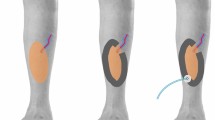Abstract
Wound complications of the pedal incision continue to compromise successful limb salvage following aggressive revascularization. Significant distal wound disruption occurred in 14 of 142 (9;8%) patients undergoing pedal bypass with autogenous vein for limb salvage between 1986 and 1993. One hundred forty-two pedal bypass procedures were performed for rest pain in 66 patients and tissue necrosis in 76. Among the 86 men and 56 women, 76% were diabetic and 73% were black. All but eight patients had a history of diabetes and/or tobacco use. Eight wounds were successfully managed with maintenance of patent grafts from 5 to 57 months. Exposure of a patent graft precipitated amputation in three patients, as did graft occlusion in an additional patient. One graft was salvaged by revision to the peroneal artery and one was covered by a local bipedicled flap. Multiple regression analysis identified three factors associated with wound complications at the pedal incision site: diabetes mellitus (p=0.03), age >70 years ( p =0.03), and rest pain ( p =0.05). Ancillary techniques (“pie-crusting”) to reduce skin tension resulted in no distal wound problems among 15 patients considered to be at greatest risk for wound breakdown. Attention to technique of distal graft tunneling, a wound closure that reduces tension, and control of swelling by avoiding dependency on and use of gentle elastic compression assume crucial importance in minimizing pedal wound complications following pedal bypass.
Similar content being viewed by others
References
Buchbinder D, Pasch AR, Verta MJ, et al. Ankle bypass: Should we go the distance? Am J Surg 1985;150:216–219.
Corson JD, Karmody AM, Shah DM, et al. In situ vein bypasses to distal tibial and limited outflow tracts for limb salvage. Surgery 1984;96:756–780.
Pomposelli FB Jr, Jepsen SJ, Gibbons GW, et al. Efficacy of the dorsal pedal bypass for limb salvage in diabetic patients: Short-term observations. J Vasc Surg 1990;117:745–752.
Harrington EB, Harrington ME, Schanzer H, et al. The dorsalis pedis bypass: Moderate success in difficult situations. J Vasc Surg 1992;15:409–416.
Shah DM, Darling RC III, Chang BB, et al. Is long bypass from groin to ankle a durable procedure? An analysis of a ten year experience. J Vasc Surg 1992;15:402–408.
Andros G, Harris RW, Salles-Cunha SX, et al. Bypass grafts to the ankle and foot. J Vasc Surg 1988;7:785–794.
Ascer E, Veith FJ, Gupta SK. Bypasses to plantar arteries and other tibial branches: An extended approach to limb salvage. J Vasc Surg 1988;8:434–441.
Klamer TW, Lambert GE, Richardson JD, et al. Utility of inframalleolar artery bypass grafting. J Vasc Surg 1990;11: 164–170.
Buchbinder D, Pasch AR, Rollins DL, et al. Results of arterial reconstruction of the foot. Arch Surg 1986;121:673–677.
Quinones-Baldrich WJ, Colburn MD, Ahn SS, et al. Very distal bypass for salvage of the severely ischemic extremity. Am J Surg 1993;166:117–123.
Taylor LM Jr, Edwards JM, Porter JM, et al. Reversed vein bypass to infrapopliteal arteries: Modern results are superior to or equivalent to in situ bypass for patency and for vein utilization. Ann Surg 1987;205:90–97.
Harris HW, Rapp JH, Reilly LM, et al. Saphenous vein bypass to pedal arteries. An aggressive strategy for foot salvage. Arch Surg 1989;124:1232–1235.
Tannebaum GA, Pomposelli FB Jr, Marcaccio EJ, et al. Safety of vein bypass grafting to dorsalis pedis artery in diabetic patients with foot infections. J Vasc Surg 1992;15:982–988.
Schwartz ME, Harrington EB, Schanzer H. Wound complications after in situ bypass. J Vasc Surg 1988;7:802–807.
Wengrovitz M, Atnip RG, Gifford RRM, et al. Wound complications of autogenous subcutaneous infrainguinal arterial bypass surgery: Predisposing factors and management. J Vasc Surg 1990;11:156–163.
Reifsnyder T, Bandyk D, Seabrook G, et al. Wound complications of the in situ saphenous vein bypass technique. J Vasc Surg 1992, 15:843–850.
Elliott BM, Robison JG, Brothers TE, et al. Limitations of peroneal artery bypass grafting for limb salvage. J Vasc Surg 1993, 18:881–888.
Kaplan EL, Meier P. Nonparametric estimation from incomplete observations. J Am Stat Assoc 1958;53:457–481.
Ouriel K, Geary KJ, Green RM, et al. Fate of the exposed saphenous vein graft. Am J Surg 1990;160:148–150.
Calligaro KD, Veith FJ, Schwartz ML, et al. Management of infected lower extremity autologous vein grafts by selective graft preservation. Am J Surg 1992;164:291–294.
Casey J, Flinn WR, Yao JST, et al. Correlation of immune and nutritional status with wound complications in patients undergoing vascular operations. Surgery 1984;93:822–827.
Heughan C, Chir B, Grislis G, et al. The effect of anemia on wound healing. Ann Surg 1974;179:163–167.
Bunt TJ, Malone JM. Amputation or revascularization in the 70 year old. Am Surg 1994;60:349–352.
Hallock GG. Bipedicled fasciocutaneous flaps in the lower extremity. Ann Plast Surg 1992;29:397–401.
Calligaro KD, Veith FJ, Sales CM, et al. Comparison of muscle flaps and delayed secondary intention wound healing for infected lower extremity arterial grafts. Ann Vasc Surg 1994; 8:31–37.
Ciresi KF, Anthony JP, Hoffman WY, et al. Limb salvage and wound coverage in patients with large ischemic ulcers: A multidisciplinary approach with revascularization and free tissue transfer. J Vasc Surg 1993; 18:648–655.
Author information
Authors and Affiliations
About this article
Cite this article
Robison, J.G., Ross, J.P., Brothers, T.E. et al. Distal wound complications following pedal bypass: Analysis of risk factors. Annals of Vascular Surgery 9, 53–59 (1995). https://doi.org/10.1007/BF02015317
Issue Date:
DOI: https://doi.org/10.1007/BF02015317




